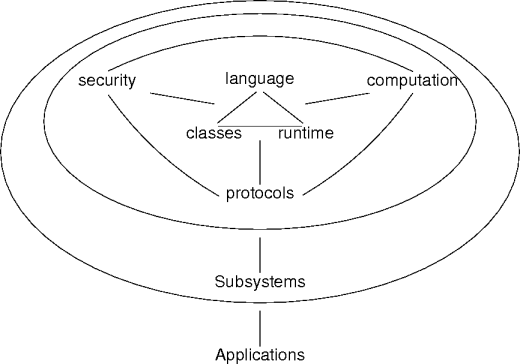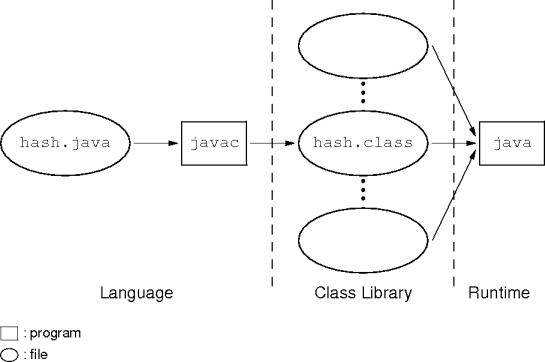Object-Oriented Programming with Java Lecture Notes
20 January 2009 • Introduction
Outline
- Java.
- Some buzzwords.
- Some history.
- Some clarification.
What is Java?
- Java is
A language.
A class library (3000+ classes).
An execution environment (the JVM).
A computation model (reflection, dynamic distributed computing).
A security model (verified bytecodes, sandboxed execution).
A protocol set (JNI, RMI, Serialization, ...)
Subsystems (JINI, JXTA, JavaBeans, ...)
Java is What?

The Java Environment

Java is …
Simple
Robust
Object oriented
Interpreted
Architecture neutral, redundant with interpreted.
Portable, redundant with interpreted.
High performance, yeah whatever.
Secure, too complicated.
Dynamic, advanced class.
Distributed, different class.
Multithreaded, different class.
Simple
- Java the language is simple on average.
- Syntactically it's too simple.
- Java the system is not simple.
- Which part of the class library is of interest?
Object-Oriented
- Java the language is mostly object-oriented.
- Almost everything's an object.
- Except the basic types (int, boolean, ...).
- Java the system is object-oriented too.
- Distributed systems really shine.
Robust
- Java programs have a set of expected error sources.
- The set’s smaller and simpler than sets for some other languages.
- For example, there are still pointer problems.
- And there’s the usual (C++) boneheadedness.
- Programs that abort in an orderly fashion with exceptions are just as useless as programs that abort with a coredump.
Interpreted
- The interpreter (the Java Virtual Machine, JVM) is the heart of the Java system.
- Most of the system benefits flow from the JVM.
- Including architecture neutrality and portability.
- As do most of the problems, particularly performance.
- The problems won’t bother us in this course.
- Except, perhaps, for security.
Java History
-
1991, A language for networked consumer devices.
1992, Marketing and failure.
1993-4, Spin-off and failure, browsers and success.
1995, Java 1.0 proof of concept.
1996, Java 1.0 and 1.1 released.
1998, Java 1.2 released.
Java at Work
- Java’s ended up in four main environments:
- The browser (applets); not so much these days.
- The server (JSP, servlets, frameworks); Java’s widest use.
- The desktop (programs); winning over C++, less so Microsoft.
- Portables (cell phones, &c); unclear but promising.
- It’s applets and programs in this course.
Java ≠ JavaScript
- Java and JavaScript are unrelated languages.
- Netscape used “JavaScript” to annoy Sun.
- JavaScript is now properly called ECMAScript.
- In a browser Java wins and JavaScript loses.
- JavaScript is wildly unsecure, and will always be so.
- But JavaScript’s simpler, faster, and in the browser.
- Java’s none of these things.
Java: Blue or White?
- James Gosling has called Java a blue-collar programming language.
- Negatively, not a PhD-driven research language.
- Positively, a language for working programmers to get things done.
- Note: blue-collar ≠ stupid.
- “Java programmers won't understand that” is not a good counter-argument.
Java as Bureaucracy
- Java’s a white-collar language too.
- Object-oriented systems can be bureaucractic organizations.
- Positively, a bureaucracy organizes and streamlines complexity.
- Negatively, a bureaucracy is inflexible and expensive off the path.
- This course rejects, but cannot avoid, a bureaucratic view of Java.
Summary
- Java is a system, not just a language.
- In some areas, compared to some languages, Java is ok.
- The JVM is slick.
- Java wanted to be everywhere, and may still be.
- Java ≠ JavaScript.
- And possibly Java > JavaScript
References
- The Feel of Java by James Gosling in IEEE Computer, June, 1997.
- The New New Thing by Michael Lewis, W. W. Norton, 1999. HD 9696.63.U62 C585
